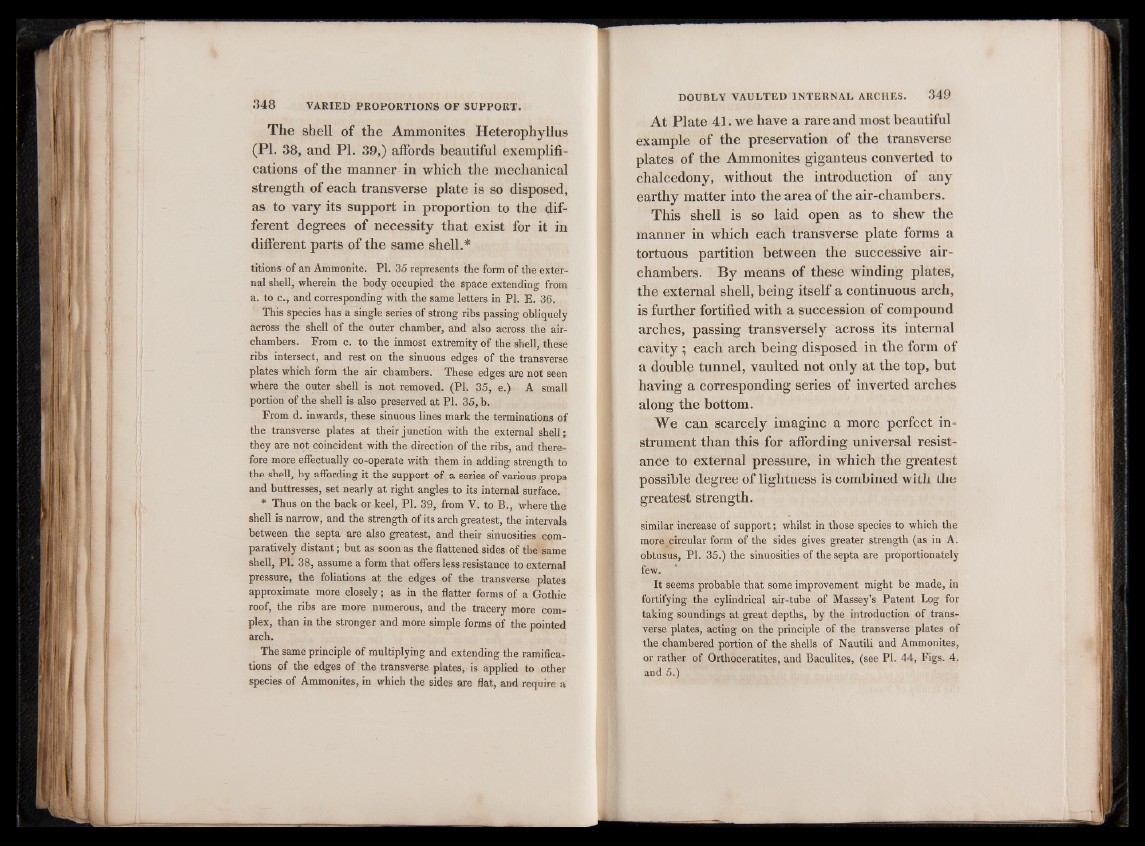
The shell of the Ammonites Heterophyllus
(PL 38, and PL 39,) affords beautiful exemplifications
of the manner in which the mechanical
strength of each transverse plate is so disposed,
as to vary its support in proportion to the different
degrees of necessity that exist for it in
different parts of the same shell.*
titions of an Ammonite. PI. 35 represents the form of the external
shell, wherein the body occupied the space extending from
a. to c., and corresponding with the same letters in PI. E. 36.
This species has a single series of strong ribs passing obliquely
across the shell of the outer chamber, and also across the air-
chambers. From c. to the inmost extremity of the shell, these
ribs intersect, and rest on the sinuous edges of the transverse
plates which form the air chambers. These edges are not seen
where the outer shell is not removed. (PL 35,. e.) A small
portion of the shell is also preserved at PI. 35, b.
From d. inwards, these sinuous lines mark the terminations of
the transverse plates at their junction with the external shell;
they are not coincident with the direction of the ribs, and therefore
more effectually co-operate with them in adding strength to
the shell, by affording it the support of a series of various props
and buttresses, set nearly at right angles to its internal surface.
* Thus on the back or keel, PI. 39, from V. to B., where the
shell is narrow, and the strength of its arch greatest, the intervals
between the septa are also greatest, and their sinuosities comparatively
distant; but as soon as the flattened sides of the same
shell, PI. 38, assume a form that offers less resistance to external
pressure, the foliations at the edges of the transverse plates
approximate more closely; as in the flatter forms of a Gothic
roof, the ribs are more numerous, and the tracery more complex,
than in the stronger and more simple forms of the pointed
arch.
The same principle of multiplying and extending the ramifications
of the edges of the transverse plates, is applied to other
species of Ammonites, in which the sides are flat, and require a
DOUBLY VAULTED INTERNAL ARCHES. 349
At Plate 41. we have a rare and most beautiful
example of the preservation of the transverse
plates of the Ammonites giganteus converted to
chalcedony, without the introduction of any
earthy matter into the area of the air-chambers.
This shell is so laid open as to shew the
manner in which each transverse plate forms a
tortuous partition between the successive air-
chambers. By means of these winding plates,
the external shell, being itself a continuous arch,
is further fortified with a succession of compound
arches, passing transversely across its internal
cavity ; each arch being disposed in the form of
a double tunnel, vaulted not only at the top, but
having a corresponding series of inverted arches
along the bottom.
We can scarcely imagine a more perfect instrument
than this for affording universal resistance
to external pressure, in which the greatest
possible degree of lightness is combined with the
greatest strength.
similar increase of support; whilst in those species to which the
more circular form of the sides gives greater strength (as in A.
obtusus, PI. 35.) the sinuosities of the septa are proportionately
few.
It seems probable that some improvement might be made, in
fortifying the cylindrical air-tube of Massey’s Patent Log for
taking soundings at great depths, by the introduction of transverse
plates, acting on the principle of the transverse plates of
the chambered portion of the shells of Nautili and Ammonites,
or rather of Orthoceratites, and Baculites, (see PI. 44, Figs. 4.
and 5.)